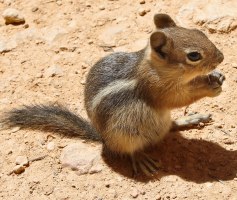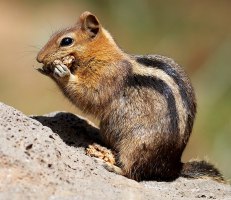 The golden-mantled ground squirrel is also often mistaken for a chipmunk, but it's bigger with black and white body stripes which don't extend onto its face. The 'mantle' across the shoulders is tawny to reddish, with males having a deeper reddish tinge.
The golden-mantled ground squirrel is also often mistaken for a chipmunk, but it's bigger with black and white body stripes which don't extend onto its face. The 'mantle' across the shoulders is tawny to reddish, with males having a deeper reddish tinge. Golden-mantled ground squirrels live in small groups in rocky places or forest litter that provides shelter. They are omnivorous, feeding on pine nuts, acorns, herbs and shrubs, fungi, many kinds of insects, eggs, young birds, lizards, carrion, and human foods when available.  This species caches food near its burrow, especially during the late summer and fall. The squirrel has also been known to 'beg' for human food where its range overlaps with areas frequented by people. Despite having no fear of humans and often persistent 'begging' behaviour, it will bite.
This species caches food near its burrow, especially during the late summer and fall. The squirrel has also been known to 'beg' for human food where its range overlaps with areas frequented by people. Despite having no fear of humans and often persistent 'begging' behaviour, it will bite.This species hibernates over the winter. During the summer they gain extra weight in order to prepare for hibernation. The squirrels hibernate in dens that can reach up to 30 metres in length, although they are often shallow in depth. A female has two to eight young per litter, with an average of five. As with most squirrels, there is no paternal care of the offspring. Juveniles resemble adults by 40 days of age. The life span of this ground squirrel is up to about seven years. Most adults are independent, rarely cooperating, and usually competing for resources. This species becomes vocal when it feels threatened, sometimes making squeaking noises or growling. Predators of this squirrel include snakes, foxes, weasels, and bears. It may carry the Rocky Mountain wood tick, a vector of Rocky Mountain spotted fever and other diseases. |